Ijraset Journal For Research in Applied Science and Engineering Technology
- Home / Ijraset
- On This Page
- Abstract
- Introduction
- Conclusion
- References
- Copyright
Flammable Gas Leakage Detection and Prevention
Authors: Vaishnavi Chavan, Harshada Kamatkar, Shaheen Tamboli
DOI Link: https://doi.org/10.22214/ijraset.2023.45622
Certificate: View Certificate
Abstract
The Internet of things (IoT) is the system of gadgets, vehicles, and home machines that contain hardware, programming, actuators, and network which enables these things to interface, collaborate and trade information. IoT includes broadening Internet network past standard device, for example, work areas, workstations, cell phones and tablets, to any scope of generally stupid or non-web empowered physical device and ordinary articles. Installed with innovation, these gadgets can convey and connect over the Internet, and they can be remotely observed and controlled [1]. The meaning of the Internet of things has advanced because of union of numerous innovations, ongoing examination, AI, ware sensors, and implanted frameworks. Conventional fields of installed frameworks, remote sensor systems, control frameworks computerization (counting home and building mechanization), and others all add to empowering the Internet of things. A gas spill alludes to a hole of petroleum gas or different vaporous item from a pipeline or other regulation into any territory where the gas ought not be available. Since a little hole may steadily develop a hazardous convergence of gas, spills are perilous. Notwithstanding causing flame and blast dangers, holes can slaughter vegetation, including huge trees, and may discharge amazing ozone harming substances to the environment.
Introduction
I. INTRODUCTION
The Internet of Things is a developing theme of specialized, social, and monetary centrality. Customer items, tough goods, cars and trucks, modern and utility segments, sensors, and other regular articles are being joined with Internet availability and amazing information systematic capacities that guarantee to change the manner in which we work, live, and play. Projections for the effect of IoT on the Internet and economy are amazing, with some foreseeing upwards of 100 billion associated IoT gadgets and a worldwide financial effect of more than $11 trillion by 2025. The Internet of Things (IoT) is an essential theme in innovation industry, strategy, and designing circles. In the case of our project, we have used part of IOT technology for lowering the causes and cases of casualties due to fire caused by gas leakage. Combustible gases are a very common reason for blasts and fire accidents, causing large damage to life and property. So here we propose an automated gas detection and alerting system that alert users wherever there is about the leakage of combustible gas and/or fire using SMS through GSM modem. We have used, ATMEGA microcontroller along with Combustible gas sensor, temperature sensor, LCD display, GSM modem and buzzer.
II. LITERATURE REVIEW
- A. Mahalingam et.al. proposed a gas leak detector in 2019 that meets the UK occupational and health standards. Gas leakage is a major concern with residential, commercial premises and gas powered transportation vehicles. One of the preventive measures to avoid the danger associated with gas leakage is to install a gas leakage detector at vulnerable locations. The objective of this work is to present the design of a cost effective automatic alarming system, which can detect liquefied petroleum gas leakage in various premises.
- K Padma Priya et al. proposed an embedded system for Gas Cylinder maintenance, in 2019 the proposed system consists of three main modules a GSM and PIC module, leakage detection module and protection circuitry. The detection module detect the gas leakage and sends SMS to the consumer through GSM. The GSM module is used to send short messages about the possibility of gas leakage.
- Sunitha. J et al. designed a wireless LPG leakage monitoring system for home safety. The proposed system detects the leakage of the LPG and alerts the consumer using GSM about the leakage and it will switch on the exhaust fan. This system also has a feature that the consumption is approximately indicated in terms of the total weight. Whenever the system detects the increase in the concentration of the LPG leakage it immediately alerts by activating an alarm and simultaneously sending message to the particular mobile phones. The fan is switched on to exhaust gas and an LPG safe valve fitted to the cylinder is closed through signals to avoid further leakage. The device assures safety and prevents explosion.
III. AIM AND OBJECTIVE
A. Aim
Developing And Working On The Project To Prevent The Flammable Gas & Fire Accident.
B. Objectives
- To prevent the dangerous flammable gas.
- To prevent the fire accident.
- To get the SMS to user if fire accident happen.
- To get alert buzzer if gas leakage happens.
IV. METHODOLOGY
- The operation of the fire and gas detection system is presented in the block diagram.
- It consist of power supply unit, which supplies needed power to the microcontroller, GSM module, gas sensor, fire sensor.
- The microcontroller is connected to the power supply unit, gas sensor, fire sensor.
- LCD shows the status of the system when there is a presence of gas or smoke which may lead to fire outbreak in the environment.
V. SPECIFICATIONS OF THE SYSTEM
A. Hardware
- Microcontroller ATMEGA328P
- Power supply
- GSM module
- MQ2 Gas sensor
- Fire sensor
- LCD display (16*2)
- Buzzer
- ESP01(Wi-Fi module)
B. Software
- Proteus
- Visual basics for embedded C programming
VI. SIMULATION DIAGRAM
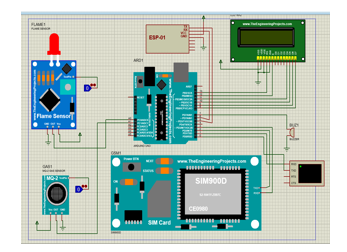
VII. HARDWARE COMPONENT DESCRIPTION
A. MQ 2 Gas Sensor
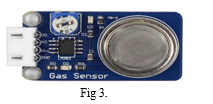
The gas sensitive material used in the MQ-2 gas sensor is SnO2, a low electrically conductive material in clean air. When there is combustible gas in the surrounding air, the electrical conductivity of the sensor will increase with the higher intensity of the combustible gas. Here, we can convert the changing electrical conductivity into output signal by building a simple circuit.
Specifications
- Detected Gas: Combustible Gas, Smoke.
- Detection Intensity: 300?10000 ppm (Combustible Gas).
- Working Voltage: 5.0V±0.1V AC or DC.
- Preheating Time: ≥2 minutes.
- VCC: 5V Working Voltage
- GND: Ground.
- D0: Output Interface of Digital Switch (0 and 1).
- A0: Analog Output Interface
B. Flame Sensor
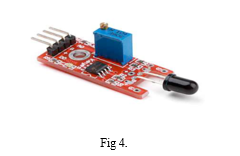
This module is sensitive to the flame and radiation. It also can detect Ordinary light source in the range of a wavelength 760nm-1100 nm. The detection distance is up to 100 cm. The Flame sensor can output digital or analog signal. It can be used as a flame alarm.
Specifications
- Detects a flame or a light source of a wavelength in the range of 760nm-1100 nm.
- Detection angle about 60 degrees, it is sensitive to the flame spectrum.
- Adjustable detection range.
- Operating voltage 3.3V-5V.
- Digital and Analog Output.
- D0 digital switch outputs (0 and 1).
- A0 analog voltage output.
- Power indicator and digital switch output indicator.
C. LCD Display 16*2
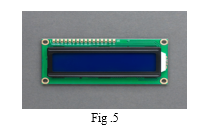
The 16x2 standard alphanumeric LCD display, they are extremely common and are a fast way to have your project show status messages. An LCD (Liquid Crystal Display) screen is an electronic display module and has a wide range of applications. A 16x2 LCD display is very basic module and is very commonly used in various devices and circuits. A 16x2 LCD means it can display 16 characters per line and there are 2 such lines. In this LCD each character is displayed in 5x7 pixel matrix. The 16 x 2 intelligent alphanumeric dot matrix display is capable of displaying 224 different characters and symbols. This LCD has two registers, namely, Command and Data.
Specifications
- The operating voltage of this display ranges from 4.7V to 5.3V.
- The operating current is 1mA without a backlight.
- PCB size of the module is 80L x 36W x 10H mm.
- LED color for backlight is green or blue.
- Number of columns – 16.
- Number of rows – 2.
D. GSM Module
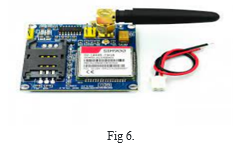
A GSM module (Global System for Mobile communication) is a hardware device that uses GSM mobile telephone technology to provide a data link to a remote network. From the view of the mobile phone network, they are essentially identical to an ordinary mobile phone, including the need for a SIM to identify themselves to the network.
Features
- Improved spectrum efficiency.
- International roaming.
- Support for new services.
- SIM phonebook management.
- Fixed dialling number (FDN)
- Real-time clock with alarm management.
- High-quality speech.
E. ATMEGA 328p
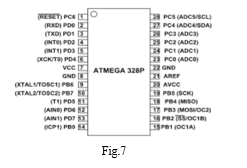
ATMEGA328P is high performance, low power controller from Microchip. ATMEGA328P is an 8-bit microcontroller based on AVR RISC architecture. It is the most popular of all AVR controllers as it is used in ARDUINO boards. Atmega328 is commonly used in many projects and autonomous systems where a simple, low-powered, low-cost micro-controller is needed. Perhaps the most common implementation of this chip is on the popular Arduino development platform, namely the Arduino Uno, Arduino Pro Mini and Arduino Nano models.
Specification
- IC type: AVR microcontroller.
- Core size: 8-bit.
- Speed: up to 20mhz.
- Number of I/O: 23.
- Program memory size: 32Kb (16K x 16)
- Program memory type: Flash.
- EEPROM size: 1K x 8.
- RAM size: 2K x 8.
F. Esp01
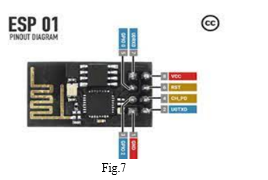
The ESP8266 wifi Module is a self contained SOC with integrated TCP/IP protocol stack that can give any microcontroller access to your wi-fi network. The ESP8266 is capable of either hosting an application or offloading all wi-fi networking functions from another application processor.
Specification
- Type - 32-bit microcontroller
- CPU - Ten silica Diamond Standard 106Micro 80 MHz (default) or 160 MHz
- Memory- 32 KB instruction, 80 KB user data
G. Buzzer

A buzzer or beeper is an audio signalling device, which may be mechanical, electromechanical, or piezoelectric. Typical uses of buzzers and beepers include alarm devices, timers, and confirmation of user input such as a mouse click or keystroke.
Specifications
- Rated Voltage: 6V DC.
- Operating Voltage: 4-8V DC.
- Rated current: <30mA.
- Sound Type: Continuous Beep.
- Resonant Frequency: ~2300 Hz.
- Small and neat sealed package.
VIII. BLOCK DIAGRAM
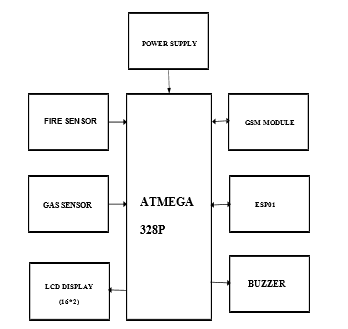
IX. WORKING
- The system is powered by a 12V power supply. The system constantly scans the gas sensor and the temperature sensor to detect leakages or high temperatures in its vicinity.
- As soon as gas is detected at the sensor, it produces an equivalent voltage and signals the micro-controller.
- The micro-controller on reading the signal checks the amount of gas detected, On detecting gas above certain level it then goes into alert mode.
- The system now displays the status of the event occurred on an LCD display, also sounds a buzzer to alert.
- It now uses the GSM modem to send an SMS message to the user/authority to inform about the situation so required action can be taken for it.
- A similar procedure is followed by the system whenever the system detects temperatures higher than the set temperature in the system.
X. EXPECTED RESULTS
|
FLAME SESNOR |
GAS SENSOR |
RESULT/ MESSAGEDISPLAYED ON LCD DISPLAY |
|
1 |
1 |
NO HAZARDS FOUND; SYSTEM IS OKAY |
|
1 |
0 |
Gas detected; SMS send |
|
0 |
1 |
Fire detected; SMS send |
|
0 |
0 |
Fire and gas detected; SMS send |
XI. AKNOWLEDGEMENT
It is my great pleasure in expressing sincere and deep gratitude towards my guide Mrs. Archana Ubale. Assistant Professor Electronics & Telecommunication Engineering Department for her valuable guidance and constant support throughout this work and help to peruse additional studies in “Flammable Gas & Fire Accident Prevention Project”.
We take this opportunity to thank Head of the Department Dr. MP. Sardey and Project coordinator Prof. Archana Ubale and all staff members of department of Electronics &Telecommunication Engineering AISSMS IOIT, Pune, for cooperation provided by them in many ways. The motivation factor for this work was the inspiration given by our honourable principal Dr. P. B. Mane.
Lastly. I am thankful to those who have directly or indirectly supported for our work.
|
Principal- Dr. P.B Mane |
HOD- Dr. MP. Sardey |
Guide- Prof. Archana Ubale |
|
Sign |
Sign |
Sign |
Conclusion
The advantage of this simple gas leak detector is its simplicity and its ability to warn about the leakage of the LPG gas. This system uses GSM technique to send alert massage to respective person if no one is there in the house and then gas leaks occurs, GSM module is there to send immediate messages to the respective person regarding the gas leak and to avoid any damage or serious casualties.
References
[1] Mahalingam, A.; Naayagi, R.T.; Mastorakis, N.E. Design and implementation of an economic gas leakage detector. In Proceedings of 6th International Conference on Circuits, Systems and Signals, Athens, Greece, 7–9 March 2012; pp. 20–24. [2] Attia, H.A.; Halah, Y.A. Electronic Design of Liquefied Petroleum Gas Leakage Monitoring, Alarm, and Protection System Based on Discrete Components. Int. J. Appl. Eng. Res. 2016, 11, 9721–9726. [3] Apeh, S.T.; Erameh, K.B.; Iruansi, U. Design and Development of Kitchen Gas Leakage Detection and Automatic Gas Shut off System. J. Emerg. Trends Eng. Appl. Sci. 2014, 5, 222–228. Eng. Proc. 2020, 2, 28 6 of 6 [4] Soundarya, T.; Anchitaalagammai, J.V.; Priya, G.D.; Karthickkumar, S.S. C-Leakage: Cylinder LPG Gas Leakage Detection for Home Safety. IOSR J. Electron. Commun. Eng. 2014, 9, 53–58. [5] Shrivastava, A.; Prabhaker, R.; Kumar, R.; Verma, R. GSM based gas leakage detection system. Int. J. Emerg. Trends Electr. Electron. 2013, 3, 42–45. [6] Anurupa, A.; Gunasegaram, M.; Amsaveni, M. Efficient Gas Leakage Detection and Control System using GSM Module. Int. J. Eng. Res. Technol.2015,3, 1–4. [7] Meenakshi, A.A.; Meghana, R.B.N.; Krishna, P.R. LPG Gas Leakage Detection and Prevention System. Int. J. Future Revolut. Comput. Sci. Commun. Eng. 2017, 3, 1–4. [8] All Answers Ltd. GSM Based LPG Detection [Internet]. November 2018. Available online: https://ukdiss.com/examples/gsm-based-lpg-detection.php?vref=1 (accessed on 15 October 2020).
Copyright
Copyright © 2023 Vaishnavi Chavan, Harshada Kamatkar, Shaheen Tamboli. This is an open access article distributed under the Creative Commons Attribution License, which permits unrestricted use, distribution, and reproduction in any medium, provided the original work is properly cited.

Download Paper
Paper Id : IJRASET45622
Publish Date : 2022-07-14
ISSN : 2321-9653
Publisher Name : IJRASET
DOI Link : Click Here
 Submit Paper Online
Submit Paper Online

